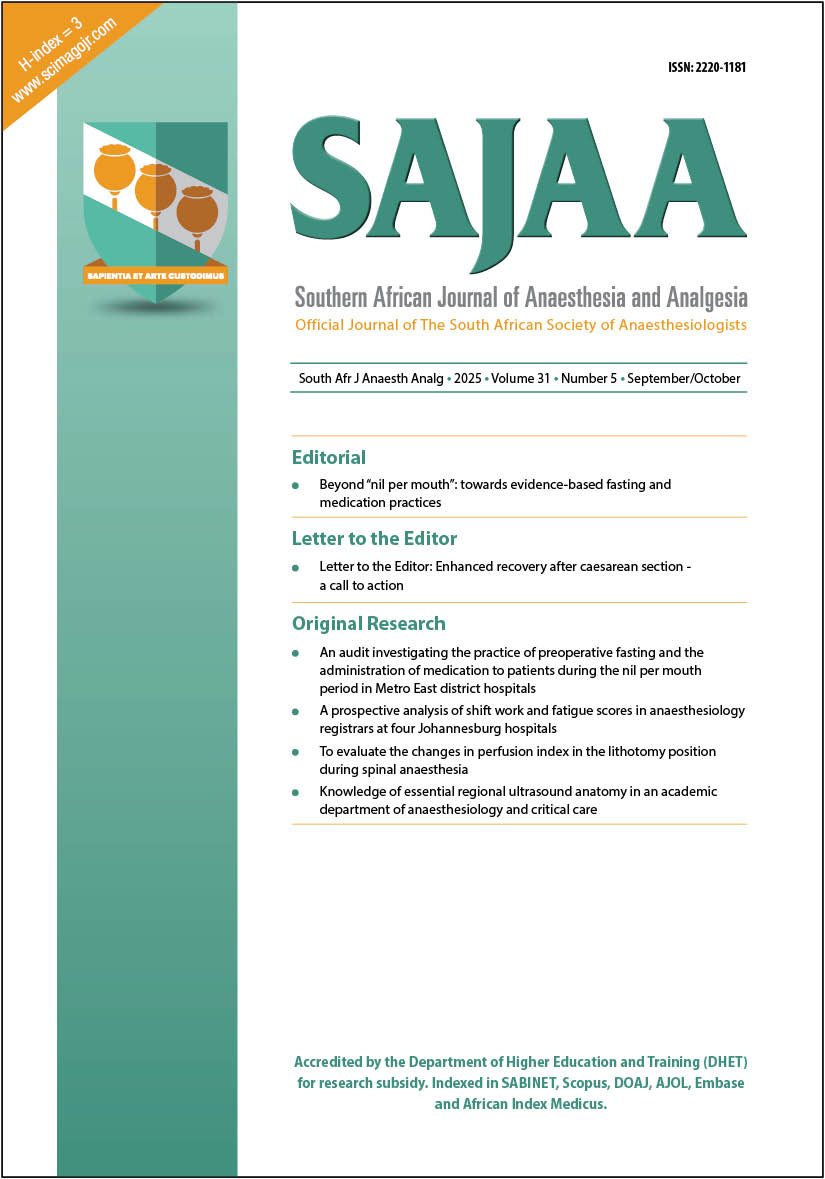To evaluate the changes in perfusion index in the lithotomy position during spinal anaesthesia
DOI:
https://doi.org/10.36303/SAJAA.3222Keywords:
perfusion index, spinal anaesthesia, lithotomy, pulse oximetry, tissue perfusionAbstract
Background: Spinal anaesthesia induces lumbosacral sympathetic blockade. The lithotomy position is an add-on to spinal anaesthesia vasodilation, which further compromises tissue perfusion. This study aimed to identify the changes in perfusion index (PI) in the upper and lower limbs in the lithotomy position following spinal anaesthesia. A comparison of PI changes in the upper and lower limbs was a secondary objective.
Methods: A total of 100 patients, aged 18–60 years, with an American Society of Anesthesiologists (ASA) physical status of 1 and 2, and scheduled for surgery under spinal anaesthesia in the lithotomy position, were included. Baseline PI was measured using a specific pulse oximeter probe (Masimo Radical-7® Pulse CO-Oximeter®, Masimo Corp., Irvine, United States), one at the fingertip and another at the toe. The lithotomy position was made after 10 minutes of spinal anaesthesia. The PI was noted subsequently at different time periods at both sites. Mean arterial pressure (MAP), heart rate (HR), and SpO2 were also recorded.
Results: The mean PI value measured in the toe increased immediately after spinal anaesthesia, and reached a peak at 10–15 minutes, then decreased progressively in the lithotomy position. In the postoperative period, PI increased immediately after positioning the patient supine, and subsequently decreased, reaching near-baseline values. These changes in PI in toe at all the time periods were clinically significant. Conversely, PI values measured in the fingertip at all the time periods were clinically insignificant.
Conclusion: PI can be used to estimate circulatory states. Therefore, its use is recommended to prevent circulatory compromise in the lower limbs following spinal anaesthesia and the lithotomy position.
Downloads
Published
Issue
Section
License
Copyright (c) 2025 Author/s

This work is licensed under a Creative Commons Attribution-NonCommercial 4.0 International License.
By submitting manuscripts to SAJAA, authors of original articles are assigning copyright to the SA Society of Anaesthesiologists. Authors may use their own work after publication without written permission, provided they acknowledge the original source. Individuals and academic institutions may freely copy and distribute articles published in SAJAA for educational and research purposes without obtaining permission.
The work is licensed under a Creative Commons Attribution-Non-Commercial Works 4.0 South Africa License. The SAJAA does not hold itself responsible for statements made by the authors.

